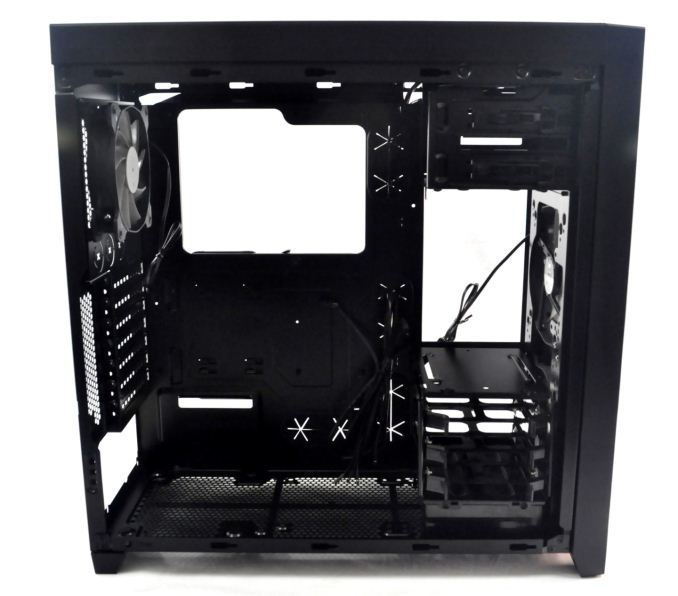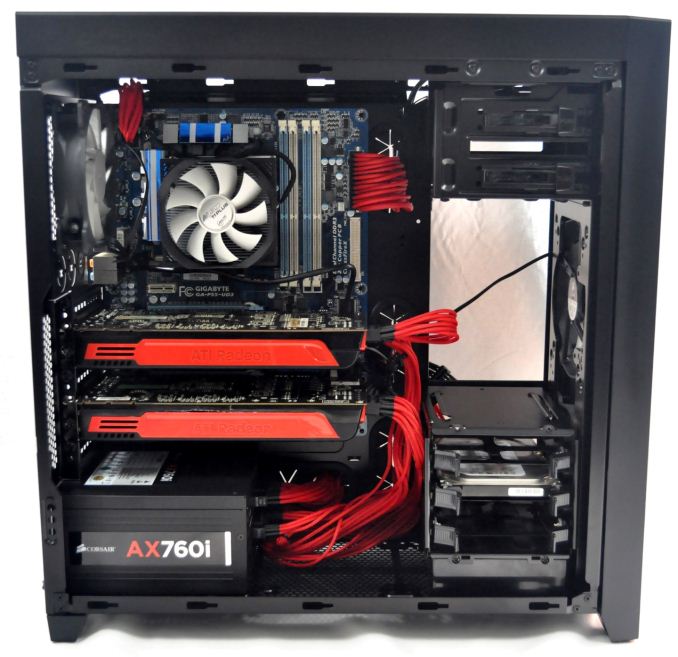Corsair Obsidian 450D Case Review
by E. Fylladitakis on April 4, 2014 6:00 AM EST- Posted in
- Cases/Cooling/PSUs
- Corsair
- mid-tower
- Case
Corsair Obsidian 450D Interior
The Obsidian 450D is entirely black and that includes every part of the interior, with the sole exception being the grey blades of the cooling fans. Mechanically, the Obsidian 450D is well designed for a case this size; most of the support depends on the motherboard tray, which is attached to the front panel via the 5.25" drive cage and a second support brace near the bottom of the case. A little flex is expected on the heavily perforated rear panel but there's nothing out of the ordinary.
The size of the motherboard tray is typical, designed to hold a full ATX motherboard. A huge opening assures the easy installation of most CPU coolers without the need to remove the motherboard from the case. Of course, smaller motherboards (Micro-ATX and Mini-ITX) can also be installed in the Obsidian 450D. Mini-ATX and narrow ATX motherboards will fit as well, but their right side will be far away from the cable hole openings and they will not cover the CPU cooler opening entirely. The clearance between the motherboard tray and the top panel is good, ensuring that liquid cooling radiators will fit; however, we strongly suggest sticking with <40mm thick radiator designs; otherwise the installation of the radiator can be obstructed by motherboard components.
It is possible to use a PSU of virtually any length with the Obsidian 450D. However, if you want to use the optional bottom intake, you need to stick with units that are 160mm long or shorter. In the case that you want to install a liquid cooling radiator there, we strongly suggest selecting a PSU that has the cable opening and/or modular connectors high up on the casing, as otherwise they might obstruct the installation of the radiator.
A single cage for up to three disk drives comes installed in the Obsidian 450D from the factory floor, with the option to add a second cage if necessary. The second cage is not included and has to be purchased separately. Each cage has three plastic trays, for the installation of an equal number of drives. Each tray can hold one 3.5" or 2.5" drive. 3.5" drives are secured by simply flexing the tray to make the metallic studs go into the screw holes of the drive, but screws are necessary for the installation of 2.5" drives. The cage itself is removable and can be installed near the bottom of the case, as pictured, or below the 5.25" drives cage. If you have plans on installing a radiator or fan at the bottom of the Obsidian 450D, the plastic frame that the drive cage sits on will have to be removed as well; this is done by removing four screws from the bottom of the case.
As is typical with all well-designed tower cases, there is ample clearance (21.3 mm from the tray to the side panel) behind the motherboard tray for the routing of cables. Corsair cleverly took advantage of that clearance and installed two additional 2.5" drive slots behind the motherboard tray. The slots are extremely easy to use; all it takes is to push a 2.5" HDD or SSD in the slot and it locks the drive into place.
Black cables and parts are easily hidden inside an all-black chassis; therefore, for visual clarity, we are using an AX760i PSU with a red cable pack and white SATA cables for our pictures. Building a system inside the Obsidian 450D is a nice experience, with most of the time required being for the routing of the cables. There are no sharp and or dangerous points about the Obsidian 450D that we could locate during our experience with it.
As exhibited in the pictures of our test build, the cables can be easily routed behind the motherboard tray and emerge from a grommet near their destination. For the CPU EPS 12V connector, Corsair positioned a small opening at the top left side of the motherboard tray. A graphics card of virtually any length can fit in the first PCI Express slot of the motherboard but it would be wise to stick with cards shorter than 260mm (10.1 in) for the other slots -- unless the drive cage is removed, in which case any card will fit. Most of the time required to build a system inside the Obsidian 450D will most likely be for the routing of the cables, which can make a bit of a mess behind the motherboard tray as there are very few cable tie mounting points. The 2.5" drive slots reduce the space available for the cables but they can be removed entirely if necessary.


















36 Comments
View All Comments
Larry Endomorph - Friday, April 4, 2014 - link
Nice review. But, ...Your line charts are useless for color blind people.
Add tick marks to the lines. Something like this:
http://www.excel-easy.com/examples/images/line-cha...
E.Fyll - Friday, April 4, 2014 - link
I am sorry, I cannot simply do that, the data points are far too many. I will see if I can do something about it though.Larry Endomorph - Friday, April 4, 2014 - link
Thanks.Another idea:
http://amplusmarketing.com/sites/all/themes/amplus...
The_Assimilator - Friday, April 4, 2014 - link
Sooo... it's basically a Fractal Design Arc Midi R2, with fewer hard drive trays and hard drive cage positioning options, more plastic, and a slightly different look... and the Arc Midi is $20 cheaper.Yeah, no.
The_Assimilator - Friday, April 4, 2014 - link
Oh... and the Arc Midi comes with a built-in 3-channel fan controller. Try harder, Corsair.NeatOman - Friday, April 4, 2014 - link
I like my Lian-Li PC-7HXW better, i picked it up for $90. I just inverted the side window.. it was very ugly on the outside IMOEnzoFX - Friday, April 4, 2014 - link
The proportion to cases that are useless to me, to ones I would consider for future builds here at Anandtech is retarded. How about more ITX cases?Razorbak86 - Friday, April 4, 2014 - link
"Retarded"? Seriously? Are you 12 years old?The_Assimilator - Saturday, April 5, 2014 - link
How about: no.FriendlyUser - Saturday, April 5, 2014 - link
You live in a closet and can't afford the space for a midi tower?